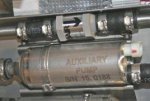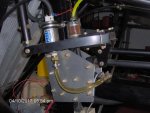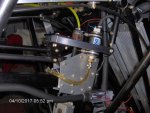So Many Questions !!!
Your automotive ECM will run the fuel pump continuously.
There was a Crash Switch in the trunk of the car to disable the pump in a crash.
You have likely not installed this important safety feature.
I have a Rotax 912iS that this information is based on.
This engine has dual independent alternators. One for the engine/ignition, one for the plane.
The pumps in the 912iS are activated when START Power is applied.
After engine start, START Power is removed and the ignition and the pumps are powered by the independent "A" Alternator.
If the engine stops for any reason, so does the alternator, and the pumps lose power and stop also.
If your main pump fails, activate the auxiliary pump.
The Aux pump is normally ON when below pattern altitude (1000 ft) while on approach and departure, just in case.
Also ON whenever not High enough to have enough time to perform a restart.
- - - - - - - - -
The fuel pickups have 1000u (micron) screen filters that block anything large enough to plug up the hoses.
The Coarse Filter (100u) blocks anything visible to the human eye that would bother the pumps.
The Fine Filter (10u) is immediately before the fuel rail and stops microscopic particles that may flake off the fuel hose from blocking the injectors.
The injector nozzles are in the 50-200u range and will not tolerate much debris.
Get out of the carburetor mindset! Fuel injected engines move a lot of fuel continuously.
1/4"fuel line is a too small to be moving >40 gph. AN6 (3/8) hose is recommended for fuel injection systems.
40gph in 1/4 hose is well over 4 ft per second. 3/8 hose will reduce that to under 2 fps.
When running two pumps the fuel passes through both pumps serially.
When running on One pump the fuel does NOT go through the other Pump.
It bypasses the other pump through the bypass valve.
The other bypass valve prevents backflow around the working pump.
These valves are NOT optional!
After the pumps, and before the Fine Filter, there is a small Orifice (Leak) to the return lines.
If the pumps ever try to pump air/vapor, they can only generate ~3psi.
This is not enough pressure to open the pressure regulator and you will be vapor locked. Bad things follow!
The only escape for this vapor will be cranking the engine long enough for the injectors to vent the air. (20-60+ seconds?)
The orifice will relieve the pressure and dump the air/vapor back to the tanks allowing the pumps to restore their prime.
The orifice also relieves the pressure in the lines after engine shutdown.
It bypasses a minor amount of fuel. We are talking about a pinhole here. (~0.015")
The return line from the engine also contains significate vapor due to the pressure drop as it comes out of the regulator.
Is must return to the tanks and never directly to the pumps.
The tanks need to be cross vented otherwise fuel sloshing through the lower Cross Flow will pump all this vapor to the atmosphere.
The vapors will recondense in the tanks as it cools.
Otherwise, you will be distilling your gas into kerosene and the fuel gets worse the farther you go.
Hopefully, the fuel will follow the path of least resistance.....which will be a perfect 50/50 split to the two tanks !!!! Who knows ...I might get lucky.
Hard Love follows! ... It is this kind of attitude that gets people killed and gyros a bad name.
Design the system so the fuel absolutely takes the path you intended.
The engine return will always have > 35gph of flow in it. your sight tubes are going to be overflowing with bubbly gas.
If this cross tank tube is also the same line that supplies fuel to the pumps, you are going to be recycling all that vapor. Very BAD!
The CrossTank connection and the fuel pick-up must be separated.
- - - - - - - -
The fuel pressure gauge is optional but very useful.
It is after the pumps but before the Fine Filter.
The Engine pressure regulator maintains ~45psi ABOVE Manifold AIr Pressure.
A Non-Differential Pressure gauge will indicate pressure above ambient.
It will indicate Gauge pressure Plus fuel filter pressure drop.
Expect to see ~45.5 psi before engine start.
~35psi at idle. And 30-45 psi in flight depending on altitude and throttle.
If it ever goes above 50psi, The fine filter needs to be changed. (Assuming NO Turbocharger.)
If it goes below 25psi The coarse filter or the pumps need servicing.
It is not required, but is worth its weight in piece-of-mind.
- - - - - - - - -
If you are using Two Seat Tanks, is one seat higher than the other?
Bill.




